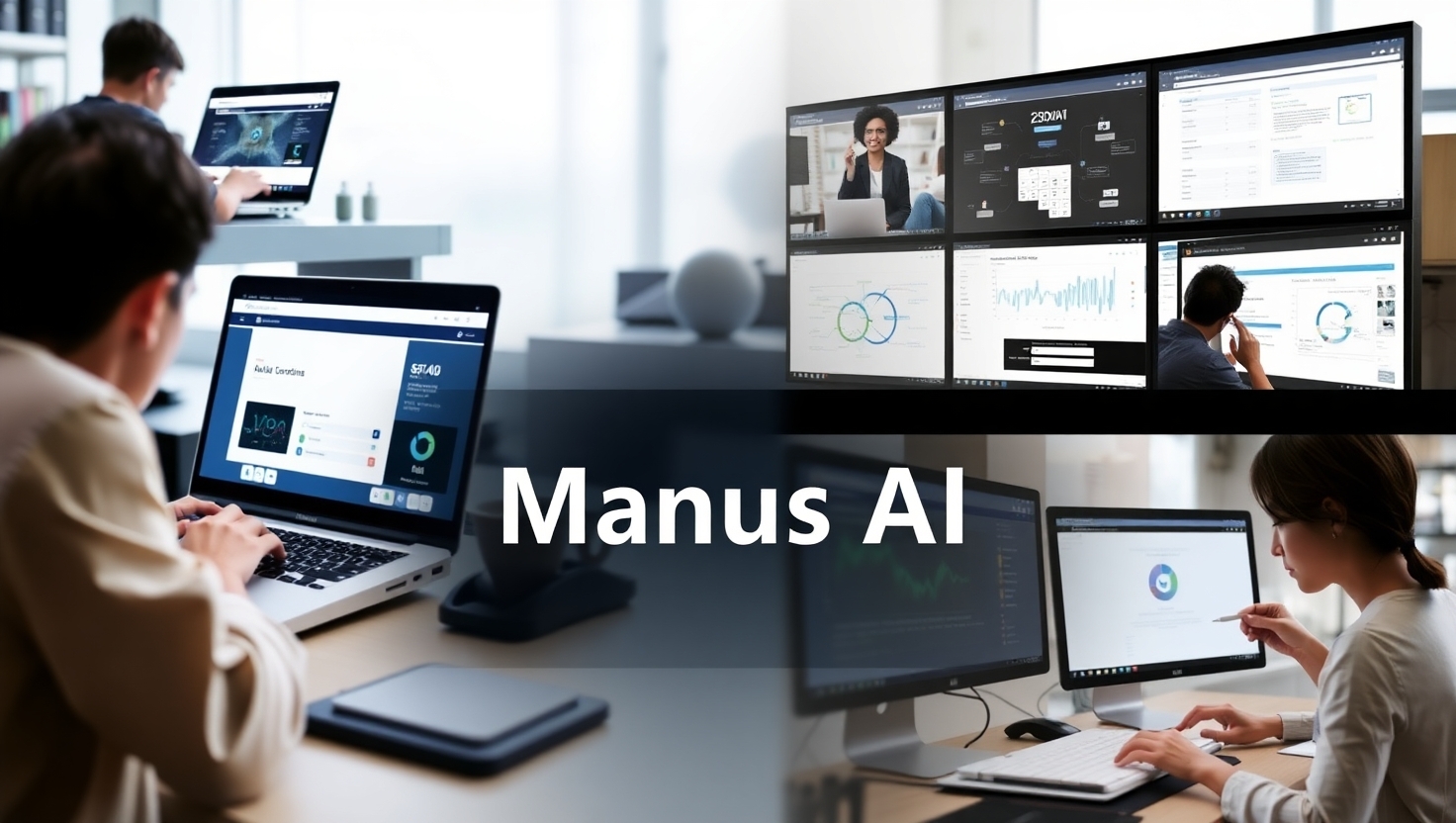In the rapidly evolving landscape of artificial intelligence, Manus AI has emerged as a groundbreaking development that’s redefining our understanding of what AI agents can accomplish. Unlike traditional AI assistants that merely respond to prompts, Manus AI represents a new generation of fully autonomous AI agents capable of executing complex tasks from start to finish with minimal human intervention. This innovative technology is bridging the gap between human thoughts and actionable results, potentially transforming how businesses and individuals approach productivity, automation, and decision-making processes. As we venture deeper into 2025, understanding Manus AI and its implications has become essential for anyone interested in the future of work and technology.
Understanding Manus AI: The World’s First Truly Autonomous AI Agent
Manus AI, developed by Chinese startup Monica.im, has gained significant attention as what many are calling the world’s first fully autonomous AI agent. Available through its official website (manus.im), this next-generation AI assistant goes beyond conventional chatbots by independently executing tasks across multiple domains.
What Makes Manus AI Different?

Traditional AI assistants typically provide responses or suggestions based on user inputs, requiring humans to implement those suggestions themselves. Manus AI takes a fundamentally different approach by autonomously completing entire workflows without constant human oversight.
For example, when tasked with creating a report on climate change, Manus doesn’t just offer information—it independently researches the topic, drafts content, generates appropriate visualizations, and compiles a comprehensive final document, all from a single prompt. This level of autonomy represents a significant leap forward in AI capabilities.
The Evolution of AI Assistants to Autonomous Agents
The progression from simple chatbots to autonomous agents like Manus AI illustrates how rapidly the field is advancing:
- First-generation AI: Rule-based systems with predetermined responses
- Second-generation AI: Machine learning models that could generate content but lacked agency
- Current generation: Autonomous agents like Manus AI that can plan and execute complex multi-step tasks independently
This evolution marks a paradigm shift from AI as an assistant to AI as an autonomous executor—potentially transforming knowledge work across industries.
Key Features and Innovations That Set Manus AI Apart
Manus AI’s revolutionary capabilities stem from several key innovations that collectively enable it to function with unprecedented autonomy and effectiveness.
1. Complete Task Autonomy
Unlike systems that merely respond to prompts, Manus AI can independently execute complex tasks such as:
- Report writing and content generation
- Spreadsheet and table creation
- Data analysis with interactive visualizations
- Travel itinerary planning
- File processing and management
Perhaps most impressively, Manus can continue working on tasks asynchronously, even when the user’s device is turned off, delivering results upon completion.
2. Multi-Agent Architecture
One of Manus AI’s most innovative aspects is its sophisticated multi-agent system. Rather than relying on a single model, Manus employs specialized sub-agents that handle specific components of tasks—such as web browsing, data analysis, or code execution.
This modular approach enables Manus to break down complex tasks into actionable steps that can be performed concurrently, significantly enhancing its problem-solving capabilities. For instance, when analyzing stocks, one sub-agent might gather market data while another examines historical trends, with a third preparing visualizations—all coordinated by an overarching system.
3. Multi-Modal Capabilities
Manus AI can process and generate multiple types of data, including:
- Text (reports, answers, creative content)
- Images (analyzing visual content, creating visualizations)
- Code (automating programming tasks, building websites)
This versatility enables Manus to handle diverse tasks that would typically require multiple specialized tools or human expertise.
4. Advanced Tool Invocation and Integration
A standout feature of Manus AI is its ability to integrate with and control external tools, including:
- Web browsers (with advanced CAPTCHA handling capabilities)
- Code editors and sandboxes
- Database management systems
- File creation and editing tools
This integration allows Manus to interact with digital environments in ways that mimic human-like task execution, such as navigating websites, executing scripts, and deploying complete solutions like functional websites directly from prompts.
5. Memory and Contextual Learning
Manus AI retains contextual memory and learns user preferences over time. For example, if instructed once to deliver results in a specific format, Manus can apply that preference to future tasks automatically, reducing repetitive instructions. This adaptive learning system ensures that the AI becomes increasingly tailored to individual users’ needs and working styles.
How Manus AI Works: The Technical Architecture
Understanding Manus AI’s technical foundation helps explain how it achieves its remarkable capabilities.
Integration of Existing Models with Specialized Fine-Tuning
Rather than building an entirely new foundational model, Manus leverages existing large language models (including Anthropic’s Claude and Alibaba’s Qwen) and fine-tunes them specifically for autonomous operation. This pragmatic approach accelerates development while enhancing performance by combining proven technologies with task-specific optimization.
Asynchronous Cloud-Based Operation
Manus AI operates in a cloud environment, allowing it to process tasks asynchronously. This architecture enables several key advantages:
- Users can initiate a task, disconnect, and receive results later
- The agent continues working independently in the background
- Tasks can be modified with new instructions without restarting
- Resources can be scaled dynamically based on task complexity
Real-Time Workflow Visibility
One unique aspect of Manus is its transparency—users can observe the AI working in real-time as it navigates websites, processes information, and builds solutions. This creates unprecedented visibility into the AI’s decision-making process, helping users understand how tasks are being completed and building trust in the system.
Open-Source Foundation
Manus builds on open-source technology, with plans to release its models publicly under an open-source license. This commitment to openness could accelerate innovation in the autonomous agent space by allowing developers to build upon and extend Manus’s capabilities.
Real-World Applications: What Can Manus AI Do?
Manus AI’s versatile capabilities enable it to handle a wide range of practical applications across various domains.
Business Operations and Research
- Comprehensive market research: Gathering and analyzing data from multiple sources to identify trends and opportunities
- Competitive analysis: Researching competitors, compiling comparative reports, and highlighting strategic insights
- Business-to-business supplier sourcing: Identifying potential vendors, comparing options, and generating detailed recommendation reports
Content Creation and Website Development
- Creating complete websites from scratch: Designing, coding, and deploying functional websites based on user requirements
- Content generation: Producing blog posts, reports, and other written content with appropriate research and citations
- Interactive course creation: Developing educational materials with assessments and interactive elements
Data Analysis and Visualization
- Stock performance analysis: Conducting correlation analyses of stocks with interactive visualizations
- Data processing: Cleaning, organizing, and analyzing large datasets
- Report generation: Creating comprehensive research documents with data-driven insights and visualizations
Personal Productivity
- Travel itinerary planning: Researching destinations, finding accommodations, and creating detailed travel plans
- Comparative research: Analyzing options (like insurance policies) to find the best fit for specific needs
- Administrative tasks: Managing emails, organizing files, and handling routine digital tasks
Manus AI vs. Competitors: The Current Landscape
While Manus AI has generated significant buzz, it exists within a competitive landscape of autonomous AI agents. Understanding how it compares to alternatives provides important context for evaluating its potential impact.
Benchmark Performance
Manus AI has reportedly achieved state-of-the-art results on the GAIA (General AI Assistants) benchmark, outperforming competitors across all difficulty levels and excelling particularly in reasoning, tool usage, and real-world problem-solving. However, it’s worth noting that benchmark performance doesn’t always translate perfectly to real-world utility.
Leading Competitors
Several competing AI agents either rival or potentially exceed Manus AI’s capabilities:
- OpenAI’s Operator and Deep Research: Potentially more reliable in certain applications
- Anthropic’s Claude: Offers competitive reliability with strong reasoning capabilities
- Emerging solutions from Google and xAI: Positioned to catch up quickly with Manus’s innovations
Current Limitations and Challenges
Despite its impressive capabilities, Manus AI does face some challenges:
- It occasionally makes errors in complex reasoning tasks
- Like all AI systems, it has limitations in understanding nuanced human context
- Being a relatively new technology, it may still have unresolved issues in specific use cases
The Future of Work with Autonomous AI Agents

The emergence of truly autonomous agents like Manus AI has profound implications for how we work and the future of various industries.
Transforming Knowledge Work
Autonomous AI agents are poised to transform knowledge work by:
- Enabling delegation of entire projects rather than just individual tasks
- Dramatically speeding up workflows for complex, multi-step processes
- Freeing human professionals to focus on higher-level strategic thinking and creativity
Potential Economic Impact
The widespread adoption of autonomous agents could lead to:
- Increased productivity across knowledge-intensive industries
- New business models built around AI-driven services
- Shifts in job roles toward AI oversight and strategic direction
Ethical Considerations and Human-AI Collaboration
As we integrate autonomous agents like Manus AI into our work:
- Questions about appropriate levels of AI autonomy need careful consideration
- Developing effective human-AI collaboration frameworks becomes crucial
- Establishing clear accountability and oversight mechanisms gains importance
Getting Started with Manus AI: A Practical Guide
For those interested in exploring Manus AI’s capabilities, here’s how to begin:
Current Availability
As of March 2025, Manus AI is available as an invitation-only web preview, showcasing its capabilities in handling complex tasks. Interested users can visit the official website (manus.im) to request access.
Ideal Use Cases for Early Adoption
When first using Manus AI, consider starting with:
- Research-intensive tasks that require synthesizing information from multiple sources
- Data analysis projects that would benefit from visualization
- Content creation workflows where Manus can gather information and generate initial drafts
- Website development projects where Manus can build functional sites from specifications
Best Practices for Working with Autonomous Agents
To get the most from autonomous agents like Manus AI:
- Provide clear, specific instructions about desired outcomes
- Give feedback on results to help the AI learn your preferences
- Start with smaller, well-defined tasks before moving to more complex projects
- Maintain appropriate oversight, especially for critical business applications
Conclusion: The Dawn of a New Era in AI
Manus AI represents a significant milestone in the evolution of artificial intelligence—marking the transition from AI as a tool to AI as an autonomous partner capable of independent action. Its ability to execute complex tasks from start to finish with minimal human intervention fundamentally changes what we can expect from AI systems.
As we look toward the future, autonomous agents like Manus AI will likely become increasingly integrated into our personal and professional lives, transforming how we approach productivity, decision-making, and creative work. The companies and individuals who most effectively leverage these autonomous capabilities may gain significant advantages in efficiency and innovation.
While challenges remain in perfecting these systems and determining appropriate boundaries for AI autonomy, one thing is clear: the era of truly autonomous AI agents has begun, and Manus AI is at the forefront of this revolutionary development.
FAQs About Manus AI
1. What makes Manus AI different from traditional AI assistants?
Unlike traditional AI assistants that only provide responses or suggestions, Manus AI autonomously executes complete tasks from start to finish, including research, content creation, data analysis, and even website development.
2. Can Manus AI work when my computer is turned off?
Yes, one of Manus AI’s key innovations is its asynchronous cloud-based operation, which allows it to continue working on tasks even when users close their devices, delivering results upon completion.
3. Who developed Manus AI?
Manus AI was developed by the Chinese startup Monica.im, with backing from a team of developers and investors from China.
4. How does Manus AI handle complex tasks?
Manus AI uses a multi-agent architecture where specialized sub-agents handle specific components of tasks under the coordination of an overarching system. This allows it to break down complex tasks into manageable steps that can be executed concurrently.
5. Is Manus AI available to the public?
As of March 2025, Manus AI is available as an invitation-only web preview through its official website (manus.im).

